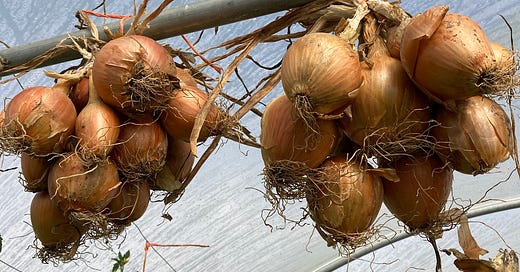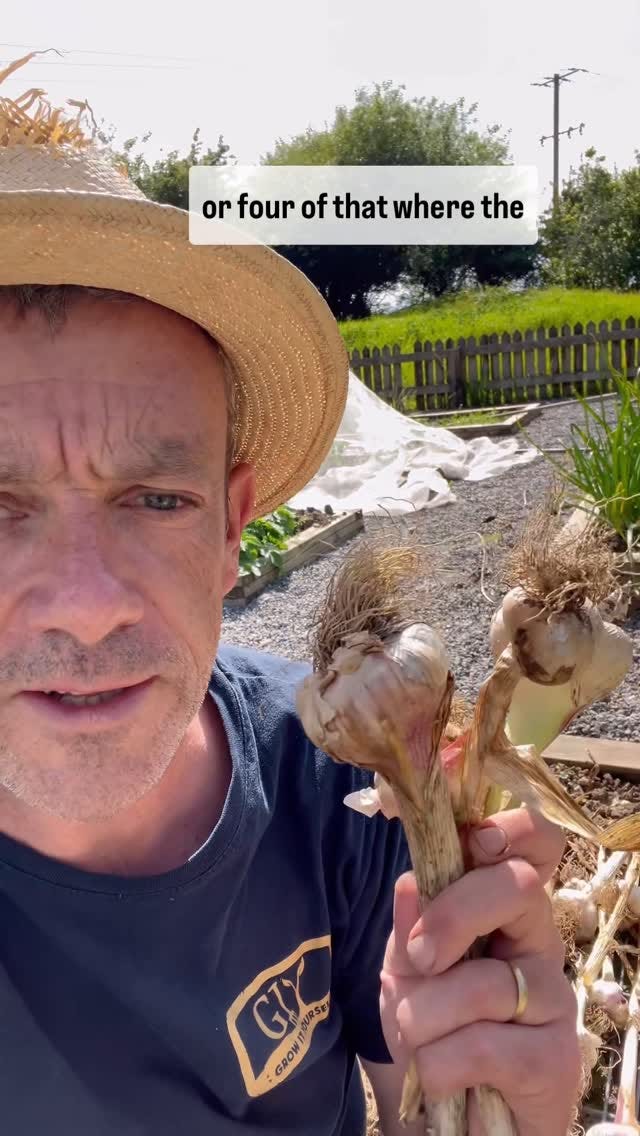IT FELT LIKE allium week here at home this week - harvesting garlic, weeding onion beds, tending to thirsty leeks and munching on tender, baked green onions in the kitchen.
Garlic
I lifted this year’s garlic crop about two weeks ago, and it’s been drying outside on a wire rack since. The general rule of thumb with garlic is that you want to harvest it before the longest day of the year (happy Solstice by the way!), but mine seemed ready a few weeks before that, probably because I sowed it in late October. I find that garlic dries best outside, even if there’s plenty of rain - it’s the exposure to the elements of wind and sun that dries them out best (and sitting up on a wire rack means that air is travelling around and underneath them).
I went through the crop yesterday, cleaning them up a bit (removing the papery skin from the heads, removing any soil and dirt from the roots, and luxuriating in the garlicky aroma) and testing them to see if they were fully dry. I discovered there’s still some green in the stems, which is a sign of moisture and from a storage perspective, moisture is bad. I removed any bulbs that were damaged or split, as they would also rot in storage, and diverted them to the kitchen to be used straight away. The rest I am going to leave to continue drying for another week or so, and if it’s very wet I will bring them in to the polytunnel to finish off. Properly dried out and hung in the marvel that is A GARLIC BRAID, garlic should last until well into next year (depending of course on how much you grew and how much you use).
Creation of THE GARLIC BRAID for hanging up in the kitchen is one of the high points of my growing year, up there with the first new potato or tomato harvest and other GIY highlights. It’s insane how much pleasure I get from this simple thing. I suppose it helps that it was garlic that began my growing journey 20 years ago, and so I suppose I retain an extra fondness for the garlic harvest. But it’s also that a GARLIC BRAID is just such a magnificent piece of art as well as being a practical storage technique. It would be like if having grown your tomatoes you were somehow able to pile them on top of each other to look like Michaelangelo’s David and display that in your kitchen for a year.
Truth be told it also looks a lot more complicated and accomplished than it is - if I can braid garlic, anyone can. My only qualification to be a GARLIC BRAIDER was derived from being very occasionally called upon to braid my daughter’s hair when she was a tiddler, presumably when her mother was away. I was always terrible at it and she would be lucky if she made it to the party or whatever event she was going to with the braid still somewhat intact. GARLIC BRAIDING is thankfully more sympathetic than daughter braiding. The GARLIC BRAID becomes a sort of semi-permanent part of the kitchen furniture for 6 months or so in our house, hanging from the dresser to serve as a daily reminder to all and sundry of what an amazing grower I am. Whether I am, truly, an amazing grower or not is irrelevant - what matters is that I was amazing enough to grow A GARLIC BRAID. Anyway, the elemental pleasures of THE GARLIC BRAID must wait another week or two, and for now I am busying myself with other aspects of the allium crop.
Leeks
It is leeks that will now replace the garlic in the allium raised beds, and I noticed yesterday that the leek seedlings are looking pretty sorry for themselves in the module tray in which I sowed them. I’ve had them in the glasshouse and they seem to be stuck rather stubbornly at the same height (perhaps 10cm or so) for the last few weeks - I think they are a little warm and dry in the glasshouse. It’s a general challenge that seedlings with well established root systems can dry out pretty dramatically in a glasshouse and overhead watering really doesn’t do enough to give them a good soaking. So I sat the module tray in to a drip dray of water outside and literally within 15 minutes the water was gone. I filled it again, and again within 15 minutes the poor thirsty leeks had drunk the whole lot! I noticed this morning that they look a lot happier and I could swear have grown a little overnight. Like everything else that remains in the glasshouse in trays or pots, the leeks will have to be planted out before our annual departure for holidays in July.
Onions
While leeks and garlic are a sort of ‘one and done’ affair from a sowing and harvesting perspective, with onions it’s more of a rolling harvest. We’ve another month or so to wait for the onions outside to be ready (a mix of red and white), but i’ve already harvested a decent crop of onions from the big polytunnel. I sowed three long rows of them in the tunnel from sets last October and we’ve been eating them since March - first, sparingly, as scallions; then more aggressively as baby onions as they grew and then finally a full harvest of big onions about two weeks ago, to make space in the tunnel for the chilli and bell peppers. This harvest yielded about 30 onions or so of varying sizes which is fantastic because it means I can let the onions outside go to their full term and there’s no hurry on them. Growing onions overwinter in the tunnel really is a fantastic use of winter tunnel space and extends the onion season dramatically. I’ve spoken about it several times in this column so you can tell I am fan.
The outside crop of onions is faring better now thanks to the rain we’ve had in the last few weeks. They were struggling a little from the dry weather prior to that. They were sown from seed in February and planted out as a cluster of onion seedlings at each space - this means you can ‘thin’ them at this time of the year - eating the ‘thinnings’ either as scallions when they are very small, or later as baby onions; and letting the rest to grow on to full size. Inspired by a post from Ballymaloe Cookery School I’ve also been eating the tender baby onions rubbed with some olive oil, they are really delicious charred in the George Foreman (or on the barbecue outside). The other job for this time of the year is to keep the onion bed free of weed so any time I can, I go up and down the onion bed with a dutch hoe to kill off any annual weeds.






